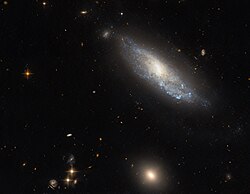NGC 297
| Galaxie Daten von NGC 297 | |
|---|---|
(c) ESA/Hubble, CC BY 4.0 | |
| Aufnahme von NGC 297 und NGC 298 mithilfe des Hubble-Weltraumteleskops | |
| AladinLite | |
| Sternbild | Walfisch |
| Position Äquinoktium: J2000.0, Epoche: J2000.0 | |
| Rektaszension | 00h 54m 58,9s [1] |
| Deklination | −07° 20′ 59″ [1] |
| Erscheinungsbild | |
| Morphologischer Typ | cE3:[1] |
| Helligkeit (visuell) | 15,5 mag[2] |
| Helligkeit (B-Band) | 16,5 mag[2] |
| Winkelausdehnung | 0,3′ × 0,2′[2] |
| Positionswinkel | 95°[2] |
| Flächenhelligkeit | 12,5 mag/arcmin²[2] |
| Physikalische Daten | |
| Rotverschiebung | 0.050778 ± 0.000150[1] |
| Radialgeschwindigkeit | (15.223 ± 45) km/s[1] |
| Hubbledistanz H0 = 73 km/(s • Mpc) | (683 ± 48) · 106 Lj (209,3 ± 14,7) Mpc [1] |
| Durchmesser | 60.000 Lj[3] |
| Geschichte | |
| Entdeckung | Albert Marth |
| Entdeckungsdatum | 27. September 1864 |
| Katalogbezeichnungen | |
| NGC 297 • PGC 3243 • 2MASX J00545892-0720591 • GC 5124 • NSA 128011 | |
NGC 297 ist eine elliptische cD-Galaxie vom Hubble-Typ E3 im Sternbild Walfisch südlich der Ekliptik. Sie ist schätzungsweise 683 Millionen Lichtjahre von der Milchstraße entfernt und hat einen Durchmesser von etwa 60.000 Lichtjahren.
Im selben Himmelsareal befinden sich u. a. die Galaxien NGC 293 und NGC 298.
Das Objekt wurde am 27. September 1864 von dem deutschen Astronomen Albert Marth entdeckt.[4]
Weblinks
Einzelnachweise
Auf dieser Seite verwendete Medien
(c) ESA/Hubble, CC BY 4.0
The spiral galaxy NGC 298 basks in this image from the NASA/ESA Hubble Space Telescope. NGC 298 lies around 89 million light-years away in the constellation Cetus, and appears isolated in this image — only a handful of distant galaxies and foreground stars accompany the lonely galaxy. While NGC 298 seems peaceful, in 1986 it was host to one of astronomy's most extreme events: a catastrophic stellar explosion known as a Type II supernova. Hubble’s Advanced Camera for Surveys captured NGC 298 as part of an investigation into the origins of Type II supernovae. All Type II supernovae are produced by the collapse and subsequent explosion of young, massive stars, but they can produce a spectacular diversity of brightnesses and spectral features. Astronomers suspect that the diversity of this cosmic firework show might be due to gas and dust being stripped from the stars that will eventually produce Type II supernovae. Observing the region surrounding supernova explosions can reveal traces of the progenitor star’s history preserved in this lost mass, as well as revealing any companion stars that survived the supernova. Hubble used the brief periods between scheduled observations to explore the aftermath of a number of Type II supernovae, hoping to piece together the relationship between Type II supernovae and the stellar systems which give rise to them.[Image description: A spiral galaxy. It is tilted diagonally, and slightly towards the viewer, making its core and disc separately visible. Its disc is speckled by small stars, has threads of dark reddish dust and bubbles of bright, glowing gas. The core shines brightly in a warmer colour. Several tiny stars and small galaxies are included in the black background.]

